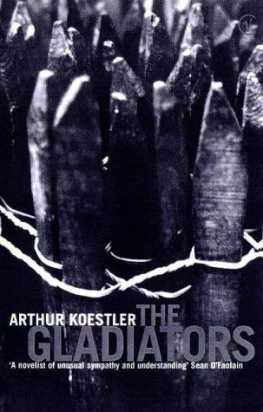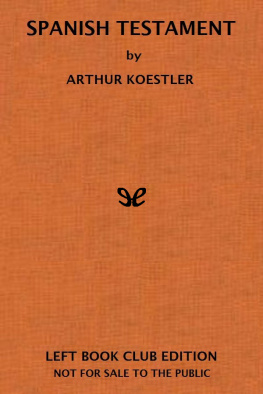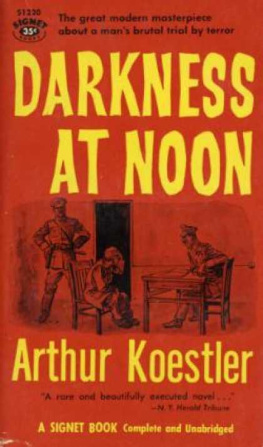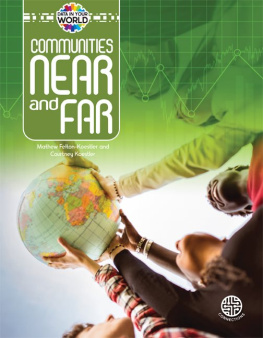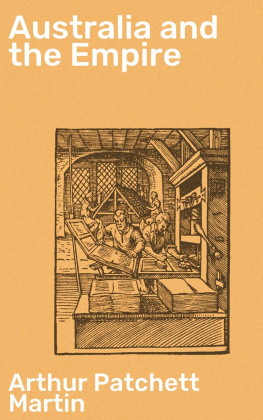Arthur Koestler - Thirteenth Tribe: Khazar Empire and Its Heritage
Here you can read online Arthur Koestler - Thirteenth Tribe: Khazar Empire and Its Heritage full text of the book (entire story) in english for free. Download pdf and epub, get meaning, cover and reviews about this ebook. year: 1976, publisher: Random House, genre: Art. Description of the work, (preface) as well as reviews are available. Best literature library LitArk.com created for fans of good reading and offers a wide selection of genres:
Romance novel
Science fiction
Adventure
Detective
Science
History
Home and family
Prose
Art
Politics
Computer
Non-fiction
Religion
Business
Children
Humor
Choose a favorite category and find really read worthwhile books. Enjoy immersion in the world of imagination, feel the emotions of the characters or learn something new for yourself, make an fascinating discovery.

- Book:Thirteenth Tribe: Khazar Empire and Its Heritage
- Author:
- Publisher:Random House
- Genre:
- Year:1976
- Rating:3 / 5
- Favourites:Add to favourites
- Your mark:
- 60
- 1
- 2
- 3
- 4
- 5
Thirteenth Tribe: Khazar Empire and Its Heritage: summary, description and annotation
We offer to read an annotation, description, summary or preface (depends on what the author of the book "Thirteenth Tribe: Khazar Empire and Its Heritage" wrote himself). If you haven't found the necessary information about the book — write in the comments, we will try to find it.
Thirteenth Tribe: Khazar Empire and Its Heritage — read online for free the complete book (whole text) full work
Below is the text of the book, divided by pages. System saving the place of the last page read, allows you to conveniently read the book "Thirteenth Tribe: Khazar Empire and Its Heritage" online for free, without having to search again every time where you left off. Put a bookmark, and you can go to the page where you finished reading at any time.
Font size:
Interval:
Bookmark:
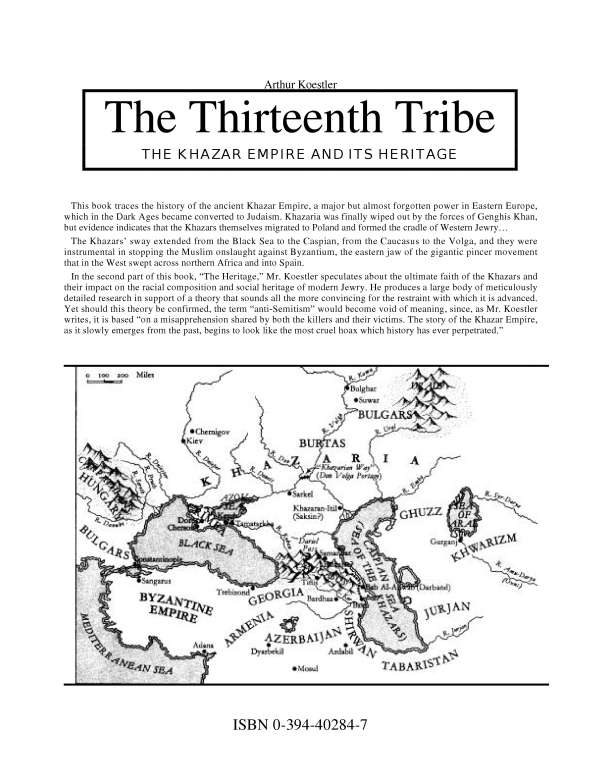
The Thirtheenth Tribe: Rise
PART ONE
Rise and Fall of the Khazars
"In Khazaria, sheep, honey, and Jews exist in large quantities."
Muqaddasi, Descriptio Imperii Moslemici (tenth century).
I
RISE
i
ABOUT the time when Charlemagne was crowned Emperor of the West, the eastern confines of Europe between the Caucasus and the Volga were ruled by a Jewish state, known as the Khazar Empire. At the peak of its power, from the seventh to the tenth centuries AD, it played a significant part in shaping the destinies of mediaeval, and consequently of modern, Europe. The Byzantine Emperor and historian, Constantine Porphyrogenitus (913-959), must have been well aware of this when he recorded in his treatise on court protocol that letters addressed to the Pope in Rome, and similarly those to the Emperor of the West, had a gold seal worth two solidi attached to them, whereas messages to the King of the Khazars displayed a seal worth three solidi. This was not flattery, but Realpolitik. "In the period with which we are concerned," wrote Bury, "it is probable that the Khan of the Khazars was of little less importance in view of the imperial foreign policy than Charles the Great and his successors.""
The country of the Khazars, a people of Turkish stock, occupied a strategic key position at the vital gateway between the Black Sea and the Caspian, where the great eastern powers of the period confronted each other. It acted as a buffer protecting Byzantium against invasions by the lusty barbarian tribesmen of the northern steppes Bulgars, Magyars, Pechenegs, etc. and, later, the Vikings and the Russians. But equally, or even more important both from the point of view of Byzantine diplomacy and of European history, is the fact that the Khazar armies effectively blocked the Arab avalanche in its most devastating early stages, and thus prevented the Muslim conquest of Eastern Europe. Professor Dunlop of Columbia University, a leading authority on the history of the Khazars, has given a concise summary of this decisive yet virtually unknown episode:
The Khazar country... lay across the natural line of advance of the Arabs. Within a few years of the death of Muhammad (AD 632) the armies of the Caliphate, sweeping northward through the wreckage of two empires and carrying all before them, reached the great mountain barrier of the Caucasus. This barrier once passed, the road lay open to the lands of eastern Europe. As it was, on the line of the Caucasus the Arabs met the forces of an organized military power which effectively prevented them from extending their conquests in this direction. The wars of the Arabs and the Khazars, which lasted more than a hundred years, though little known, have thus considerable historical importance. The Franks of Charles Martel on the field of Tours turned the tide of Arab invasion. At about the same time the threat to Europe in the east was hardly less acute.... The victorious Muslims were met and held by the forces of the Khazar kingdom.... It can... scarcely be doubted that but for the existence of the Khazars in the region north of the Caucasus, Byzantium, the bulwark of European civilization in the east, would have found itself outflanked by the Arabs, and the history of Christendom and Islam might well have been very different from what we know.
It is perhaps not surprising, given these circumstances, that in 732 after a resounding Khazar victory over the Arabs the future Emperor Constantine V married a Khazar princess. In due time their son became the Emperor Leo IV, known as Leo the Khazar.
Ironically, the last battle in the war, AD 737, ended in a Khazar defeat. But by that time the impetus of the Muslim Holy War was spent, the Caliphate was rocked by internal dissensions, and the Arab invaders retraced their steps across the Caucasus without having gained a permanent foothold in the north, whereas the Khazars became more powerful than they had previously been.
A few years later, probably AD 740, the King, his court and the military ruling class embraced the Jewish faith, and Judaism became the state religion of the Khazars. No doubt their contemporaries were as astonished by this decision as modern scholars were when they came across the evidence in the Arab, Byzantine, Russian and Hebrew sources. One of the most recent comments is to be found in a work by the Hungarian Marxist historian, Dr Antal Bartha. His book on The Magyar Society in the Eighth and Ninth Centuries has several chapters on the Khazars, as during most of that period the Hungarians were ruled by them. Yet their conversion to Judaism is discussed in a single paragraph, with
The Thirtheenth Tribe: Rise
Our investigations cannot go into problems pertaining to the history of ideas, but we must call the reader's attention to the matter of the Khazar kingdom's state religion. It was the Jewish faith which became the official religion of the ruling strata of society. Needless to say, the acceptance of the Jewish faith as the state religion of an ethnically non-Jewish people could be the subject of interesting speculations. We shall, however, confine ourselves to the remark that this official conversion in defiance of Christian proselytizing by Byzantium, the Muslim influence from the East, and in spite of the political pressure of these two powers to a religion which had no support from any political power, but was persecuted by nearly all has come as a surprise to all historians concerned with the Khazars, and cannot be considered as accidental, but must be regarded as a sign of the independent policy pursued by that kingdom.
Which leaves us only slightly more bewildered than before. Yet whereas the sources differ in minor detail, the major facts are beyond dispute.
What is in dispute is the fate of the Jewish Khazars after the destruction of their empire, in the twelfth or thirteenth century. On this problem the sources are scant, but various late mediaeval Khazar settlements are mentioned in the Crimea, in the Ukraine, in Hungary, Poland and Lithuania. The general picture that emerges from these fragmentary pieces of information is that of a migration of Khazar tribes and communities into those regions of Eastern Europe mainly Russia and Poland where, at the dawn of the Modern Age, the greatest concentrations of Jews were found. This has lead several historians to conjecture that a substantial part, and perhaps the majority of eastern Jews and hence of world Jewry might be of Khazar, and not of Semitic Origin.
The far-reaching implications of this hypothesis may explain the great caution exercised by historians in approaching this subject if they do not avoid it altogether. Thus in the 1973 edition of the Encyclopaedia Judaica the article "Khazars" is signed by Dunlop, but there is a separate section dealing with "Khazar Jews after the Fall of the Kingdom", signed by the editors, and written with the obvious intent to avoid upsetting believers in the dogma of the Chosen Race:
The Turkish-speaking Karaites [a fundamentalist Jewish sect] of the Crimea, Poland, and elsewhere have affirmed a connection with the Khazars, which is perhaps confirmed by evidence from folklore and anthropology as well as language. There seems to be a considerable amount of evidence attesting to the continued presence in Europe of descendants of the Khazars.
How important, in quantitative terms, is that "presence" of the Caucasian sons of Japheth in the tents of Shem? One of the most radical propounders of the hypothesis concerning the Khazar origins of Jewry is the Professor of Mediaeval Jewish History at Tel Aviv University, A. N. Poliak. His book Khazaria (in Hebrew) was published in 1944 in Tel Aviv, and a second edition in 1951. In his introduction he writes that the facts demand
Font size:
Interval:
Bookmark:
Similar books «Thirteenth Tribe: Khazar Empire and Its Heritage»
Look at similar books to Thirteenth Tribe: Khazar Empire and Its Heritage. We have selected literature similar in name and meaning in the hope of providing readers with more options to find new, interesting, not yet read works.
Discussion, reviews of the book Thirteenth Tribe: Khazar Empire and Its Heritage and just readers' own opinions. Leave your comments, write what you think about the work, its meaning or the main characters. Specify what exactly you liked and what you didn't like, and why you think so.


